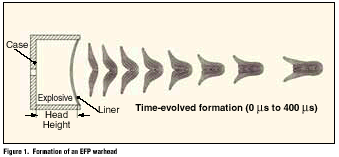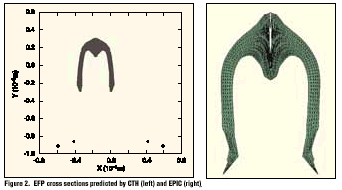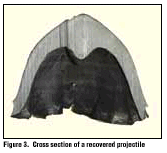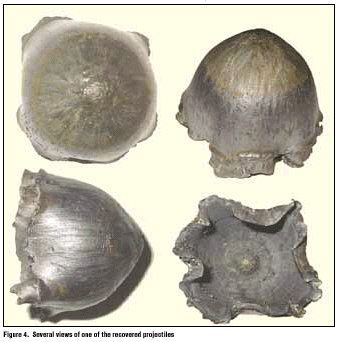|
Explosively Formed Projectiles
Scientists use design models and
shock physics codes to predict terminal shape of projectiles.
AFRL’s Munitions Directorate, Assessment and
Demonstration Division, Computational Mechanics Branch, Eglin AFB FL
Explosively formed projectiles (EFP) have been used to defeat
armored vehicles for more than 30 years. The EFP warhead was derived
from the Misznay-Schardin device,1 which consists of a right circular
cylinder of explosive, with a shallow cavity in one end that is fitted
with a thin metallic liner. Upon detonation, the liner dynamically
transforms into an aerodynamic projectile traveling at high velocity
(typically 1500-2000 m/s). Figure 1 shows the formation process for a
tactical EFP warhead from its initial predetonation state to the fully
formed profile.
 The purpose of this
effort was to create and recover EFPs using the proper explosive and
metallic cylinder combination to subject tantalum liners to conditions
that approximate realistic EFP formation without the complexities and
military sensitivity of tactically realistic final shapes. Material
samples obtained from the recovered EFPs will be used in the
development of new computer models. Because the EFPs created in this
effort were recovered intact, it was also possible to evaluate the
final shape of the actual EFPs as compared to the shape predicted by
simulations using current computer models. The purpose of this
effort was to create and recover EFPs using the proper explosive and
metallic cylinder combination to subject tantalum liners to conditions
that approximate realistic EFP formation without the complexities and
military sensitivity of tactically realistic final shapes. Material
samples obtained from the recovered EFPs will be used in the
development of new computer models. Because the EFPs created in this
effort were recovered intact, it was also possible to evaluate the
final shape of the actual EFPs as compared to the shape predicted by
simulations using current computer models.
 Recovering EFPs in a
condition suitable for scientific analysis is not a trivial exercise.
With a mass of 500 g or more, a velocity of 2000 m/s, and kinetic
energy on the order of 1 MJ, these projectiles are capable of
penetrating more than 10 cm of armor. Scientists used a softcatch
apparatus to acquire projectile and material samples.2 Softcatch
devices consist of sections of materials, selected for their density
and strength, that will stop an EFP or other fast-moving projectile
without causing excessive damage. Scientists control the deceleration
by trading off aerodynamic drag and strength forces of the target
materials. Impact pressure on the projectile’s nose is proportional to
the product of mass density of the catch material and the square of
projectile velocity. Therefore, the softcatch materials travel from
lowdensity, low-strength materials into materials with gradually
increasing density and higher strength. The softcatch apparatus used in
this effort consisted of a long steel tube filled with sections of
various materials, each section having a greater density than the
preceding one. The first tube section was 12 ft long and filled with
polystyrene. Following this section, in order, were 8 ft sections each
of vermiculite, Celotex™, and water. The last tube section, 11 ft long,
was filled with sand. Recovering EFPs in a
condition suitable for scientific analysis is not a trivial exercise.
With a mass of 500 g or more, a velocity of 2000 m/s, and kinetic
energy on the order of 1 MJ, these projectiles are capable of
penetrating more than 10 cm of armor. Scientists used a softcatch
apparatus to acquire projectile and material samples.2 Softcatch
devices consist of sections of materials, selected for their density
and strength, that will stop an EFP or other fast-moving projectile
without causing excessive damage. Scientists control the deceleration
by trading off aerodynamic drag and strength forces of the target
materials. Impact pressure on the projectile’s nose is proportional to
the product of mass density of the catch material and the square of
projectile velocity. Therefore, the softcatch materials travel from
lowdensity, low-strength materials into materials with gradually
increasing density and higher strength. The softcatch apparatus used in
this effort consisted of a long steel tube filled with sections of
various materials, each section having a greater density than the
preceding one. The first tube section was 12 ft long and filled with
polystyrene. Following this section, in order, were 8 ft sections each
of vermiculite, Celotex™, and water. The last tube section, 11 ft long,
was filled with sand.
Scientists designed a tantalum EFP for safe deceleration and recovery
by the softcatch apparatus. The probability of successfully recovering
the projectile increases as the projectile velocity decreases. However,
for the recovered material to be useful, it must have experienced a
strain path and strain rate history similar to an EFP from an actual
warhead. These requirements are contradictory, because the design
parameters that tend to create large deformation in the liner also
drive it with a high velocity (typically greater than 1500 m/s). The
geometric parameters of the warhead that have the most influence on the
projectile are the thickness of the liner and the head height of the
explosive charge. Although it is easier to softrecover a thick-walled,
slow-moving projectile, the thicker liner will undergo reduced strain
and strain rate as compared to more tactically realistic projectiles.
In this effort, scientists designed a liner that fit the best
compromise between these requirements. To obtain a suitable geometry
for the liner, scientists performed several computer simulations of
potential geometries using the EPIC and CTH shock physics codes.
 To find an optimum
design, they varied four parameters: head height of the explosive,
liner thickness at its center, profile of the top liner surface, and
profile of the bottom liner surface. Scientists fixed the explosive
head height at a minimum distance of 3 in. to ensure that the
detonation front fully developed before impacting the liner. They chose
the liner thickness so that the liner would not spall and analysis
specimens could be cut from a recovered projectile. To find an optimum
design, they varied four parameters: head height of the explosive,
liner thickness at its center, profile of the top liner surface, and
profile of the bottom liner surface. Scientists fixed the explosive
head height at a minimum distance of 3 in. to ensure that the
detonation front fully developed before impacting the liner. They chose
the liner thickness so that the liner would not spall and analysis
specimens could be cut from a recovered projectile.
The thickness profile was dictated by iterative design and its
influence on the final projectile shape. After setting the explosive
head height and liner thickness, scientists systematically altered the
top and bottom surfaces of the liner until they found an optimum
design. The geometry of the liner’s bottom surface primarily affects
the velocity of the liner as a function of radius early in the EFP
formation process. Making this surface too concave will cause the liner
material to be driven inward more than desired. Making this surface too
flat will result in a broad, flat projectile with strains lower than
desired and geometry not suitable for the deceleration forces in the
softcatch apparatus. In the final design, a third-degree polynomial
defined the liner’s bottom surface.
 Altering the geometry
of the top surface of the liner (defined by a second-degree polynomial)
relative to the bottom surface changes the thickness of the liner as a
function of radius. This changes the mass distribution and strength of
the liner across its radius. These effects determine the shape of the
liner late in the EFP formation process. While the explosive charge
accelerates the liner, the center begins to move with a greater
velocity than the outer edge. During EFP formation, the material near
the outside edge of the liner slows the material near the center of the
liner. This process produces a tremendous amount of strain in the
liner. If the liner is made too thick towards its outer edge, localized
strain will cause the metal to fail, resulting in metal chunks instead
of an EFP. Making the liner too thin will cause the same problem. A
correctly designed liner balances the competing effects. Altering the geometry
of the top surface of the liner (defined by a second-degree polynomial)
relative to the bottom surface changes the thickness of the liner as a
function of radius. This changes the mass distribution and strength of
the liner across its radius. These effects determine the shape of the
liner late in the EFP formation process. While the explosive charge
accelerates the liner, the center begins to move with a greater
velocity than the outer edge. During EFP formation, the material near
the outside edge of the liner slows the material near the center of the
liner. This process produces a tremendous amount of strain in the
liner. If the liner is made too thick towards its outer edge, localized
strain will cause the metal to fail, resulting in metal chunks instead
of an EFP. Making the liner too thin will cause the same problem. A
correctly designed liner balances the competing effects.
Figure 2 shows cross-section views along the center plane of the final
configuration of this EFP, as predicted by the CTH and EPIC codes.
Figure 3 shows a cross section of one of the recovered EFPs. Figure 4
presents several views of one of the recovered EFPs. These figures
indicate general agreement between the shape predicted by the computer
codes and the actual shape of the recovered EFP. The projectile’s
measured terminal velocity of 1450 m/s was slightly higher than the
1370 m/s predicted by the CTH code and the 1340 m/s predicted by the
EPIC code. Most of this discrepancy can be attributed to the quality of
the models available for the explosive and metal components.
Shock physics codes like CTH and EPIC will predict EFP behavior more
precisely as the quality of component models continues to improve.
Although computer simulations will never fully replace testing, more
accurate models will give the weapon designer better insight into the
underlying physics involved, reduce the number of experiments and tests
required, and therefore, reduce the cost of developing EFP warheads.
Dr. James N. Wilson, Dr. David E. Lambert, and Mr. Joel
B. Stewart, of the Air Force Research Laboratory’s Munitions
Directorate, wrote this article. For more information, contact TECH
CONNECT at (800) 203-6451 or place a request at http://www.afrl.af.mil/techconn/index.htm.
Reference document MN-04-07.
References
1 Schardin, H. “Uber das Wesen der Hohlladung.” Wehrtechnische
Monatshefte, vol 51 (1954): 97-120. 2 Draxler, V.C. “Softcatch Method
for Explosively Formed Penetrators.” 44th Meeting of the Aeroballistic
Range Association, Technische Universitat Munchen, Munich, Germany,
(Sep 93).
DISTRIBUTION
A
PUBLIC RELEASE
HOME
| ABOUT AFRL
| CONTACT US |
DISCLAIMER
The information within this website is
hosted by ABP International
|
 The purpose of this
effort was to create and recover EFPs using the proper explosive and
metallic cylinder combination to subject tantalum liners to conditions
that approximate realistic EFP formation without the complexities and
military sensitivity of tactically realistic final shapes. Material
samples obtained from the recovered EFPs will be used in the
development of new computer models. Because the EFPs created in this
effort were recovered intact, it was also possible to evaluate the
final shape of the actual EFPs as compared to the shape predicted by
simulations using current computer models.
The purpose of this
effort was to create and recover EFPs using the proper explosive and
metallic cylinder combination to subject tantalum liners to conditions
that approximate realistic EFP formation without the complexities and
military sensitivity of tactically realistic final shapes. Material
samples obtained from the recovered EFPs will be used in the
development of new computer models. Because the EFPs created in this
effort were recovered intact, it was also possible to evaluate the
final shape of the actual EFPs as compared to the shape predicted by
simulations using current computer models. Recovering EFPs in a
condition suitable for scientific analysis is not a trivial exercise.
With a mass of 500 g or more, a velocity of 2000 m/s, and kinetic
energy on the order of 1 MJ, these projectiles are capable of
penetrating more than 10 cm of armor. Scientists used a softcatch
apparatus to acquire projectile and material samples.2 Softcatch
devices consist of sections of materials, selected for their density
and strength, that will stop an EFP or other fast-moving projectile
without causing excessive damage. Scientists control the deceleration
by trading off aerodynamic drag and strength forces of the target
materials. Impact pressure on the projectile’s nose is proportional to
the product of mass density of the catch material and the square of
projectile velocity. Therefore, the softcatch materials travel from
lowdensity, low-strength materials into materials with gradually
increasing density and higher strength. The softcatch apparatus used in
this effort consisted of a long steel tube filled with sections of
various materials, each section having a greater density than the
preceding one. The first tube section was 12 ft long and filled with
polystyrene. Following this section, in order, were 8 ft sections each
of vermiculite, Celotex™, and water. The last tube section, 11 ft long,
was filled with sand.
Recovering EFPs in a
condition suitable for scientific analysis is not a trivial exercise.
With a mass of 500 g or more, a velocity of 2000 m/s, and kinetic
energy on the order of 1 MJ, these projectiles are capable of
penetrating more than 10 cm of armor. Scientists used a softcatch
apparatus to acquire projectile and material samples.2 Softcatch
devices consist of sections of materials, selected for their density
and strength, that will stop an EFP or other fast-moving projectile
without causing excessive damage. Scientists control the deceleration
by trading off aerodynamic drag and strength forces of the target
materials. Impact pressure on the projectile’s nose is proportional to
the product of mass density of the catch material and the square of
projectile velocity. Therefore, the softcatch materials travel from
lowdensity, low-strength materials into materials with gradually
increasing density and higher strength. The softcatch apparatus used in
this effort consisted of a long steel tube filled with sections of
various materials, each section having a greater density than the
preceding one. The first tube section was 12 ft long and filled with
polystyrene. Following this section, in order, were 8 ft sections each
of vermiculite, Celotex™, and water. The last tube section, 11 ft long,
was filled with sand. To find an optimum
design, they varied four parameters: head height of the explosive,
liner thickness at its center, profile of the top liner surface, and
profile of the bottom liner surface. Scientists fixed the explosive
head height at a minimum distance of 3 in. to ensure that the
detonation front fully developed before impacting the liner. They chose
the liner thickness so that the liner would not spall and analysis
specimens could be cut from a recovered projectile.
To find an optimum
design, they varied four parameters: head height of the explosive,
liner thickness at its center, profile of the top liner surface, and
profile of the bottom liner surface. Scientists fixed the explosive
head height at a minimum distance of 3 in. to ensure that the
detonation front fully developed before impacting the liner. They chose
the liner thickness so that the liner would not spall and analysis
specimens could be cut from a recovered projectile. Altering the geometry
of the top surface of the liner (defined by a second-degree polynomial)
relative to the bottom surface changes the thickness of the liner as a
function of radius. This changes the mass distribution and strength of
the liner across its radius. These effects determine the shape of the
liner late in the EFP formation process. While the explosive charge
accelerates the liner, the center begins to move with a greater
velocity than the outer edge. During EFP formation, the material near
the outside edge of the liner slows the material near the center of the
liner. This process produces a tremendous amount of strain in the
liner. If the liner is made too thick towards its outer edge, localized
strain will cause the metal to fail, resulting in metal chunks instead
of an EFP. Making the liner too thin will cause the same problem. A
correctly designed liner balances the competing effects.
Altering the geometry
of the top surface of the liner (defined by a second-degree polynomial)
relative to the bottom surface changes the thickness of the liner as a
function of radius. This changes the mass distribution and strength of
the liner across its radius. These effects determine the shape of the
liner late in the EFP formation process. While the explosive charge
accelerates the liner, the center begins to move with a greater
velocity than the outer edge. During EFP formation, the material near
the outside edge of the liner slows the material near the center of the
liner. This process produces a tremendous amount of strain in the
liner. If the liner is made too thick towards its outer edge, localized
strain will cause the metal to fail, resulting in metal chunks instead
of an EFP. Making the liner too thin will cause the same problem. A
correctly designed liner balances the competing effects.